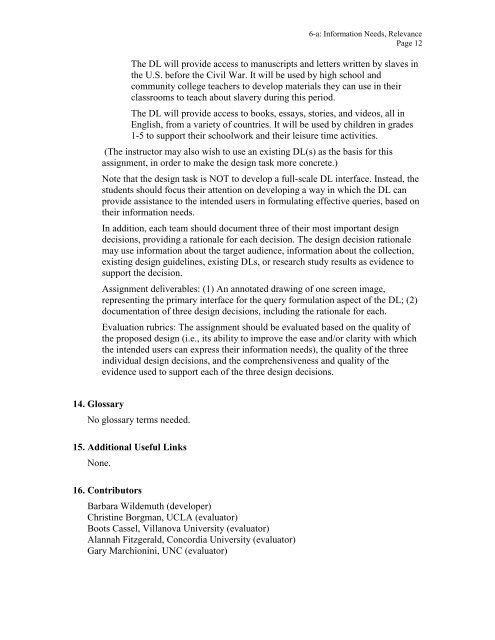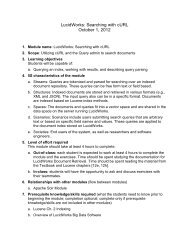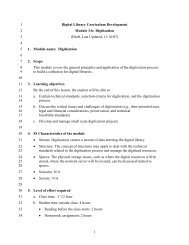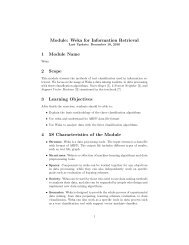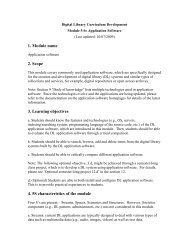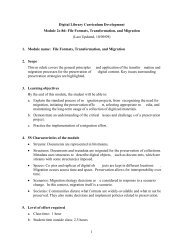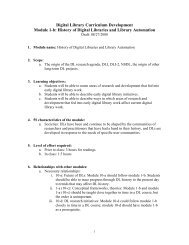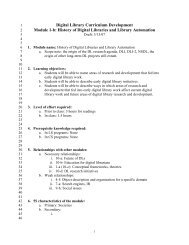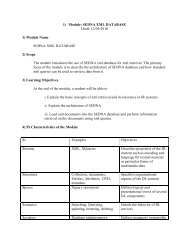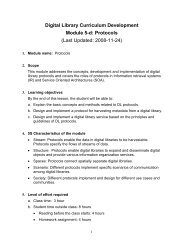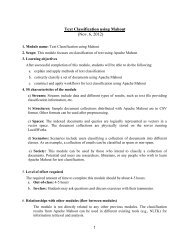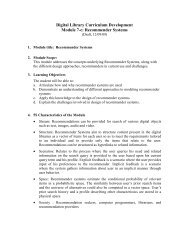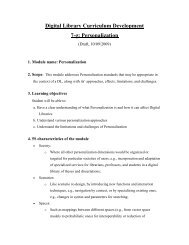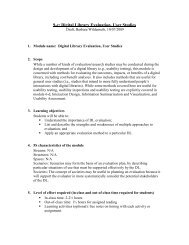Template for DL Instructional Modules - Digital Library Curriculum ...
Template for DL Instructional Modules - Digital Library Curriculum ...
Template for DL Instructional Modules - Digital Library Curriculum ...
You also want an ePaper? Increase the reach of your titles
YUMPU automatically turns print PDFs into web optimized ePapers that Google loves.
6-a: In<strong>for</strong>mation Needs, RelevancePage 12The <strong>DL</strong> will provide access to manuscripts and letters written by slaves inthe U.S. be<strong>for</strong>e the Civil War. It will be used by high school andcommunity college teachers to develop materials they can use in theirclassrooms to teach about slavery during this period.The <strong>DL</strong> will provide access to books, essays, stories, and videos, all inEnglish, from a variety of countries. It will be used by children in grades1-5 to support their schoolwork and their leisure time activities.(The instructor may also wish to use an existing <strong>DL</strong>(s) as the basis <strong>for</strong> thisassignment, in order to make the design task more concrete.)Note that the design task is NOT to develop a full-scale <strong>DL</strong> interface. Instead, thestudents should focus their attention on developing a way in which the <strong>DL</strong> canprovide assistance to the intended users in <strong>for</strong>mulating effective queries, based ontheir in<strong>for</strong>mation needs.In addition, each team should document three of their most important designdecisions, providing a rationale <strong>for</strong> each decision. The design decision rationalemay use in<strong>for</strong>mation about the target audience, in<strong>for</strong>mation about the collection,existing design guidelines, existing <strong>DL</strong>s, or research study results as evidence tosupport the decision.Assignment deliverables: (1) An annotated drawing of one screen image,representing the primary interface <strong>for</strong> the query <strong>for</strong>mulation aspect of the <strong>DL</strong>; (2)documentation of three design decisions, including the rationale <strong>for</strong> each.Evaluation rubrics: The assignment should be evaluated based on the quality ofthe proposed design (i.e., its ability to improve the ease and/or clarity with whichthe intended users can express their in<strong>for</strong>mation needs), the quality of the threeindividual design decisions, and the comprehensiveness and quality of theevidence used to support each of the three design decisions.14. GlossaryNo glossary terms needed.15. Additional Useful LinksNone.16. ContributorsBarbara Wildemuth (developer)Christine Borgman, UCLA (evaluator)Boots Cassel, Villanova University (evaluator)Alannah Fitzgerald, Concordia University (evaluator)Gary Marchionini, UNC (evaluator)


